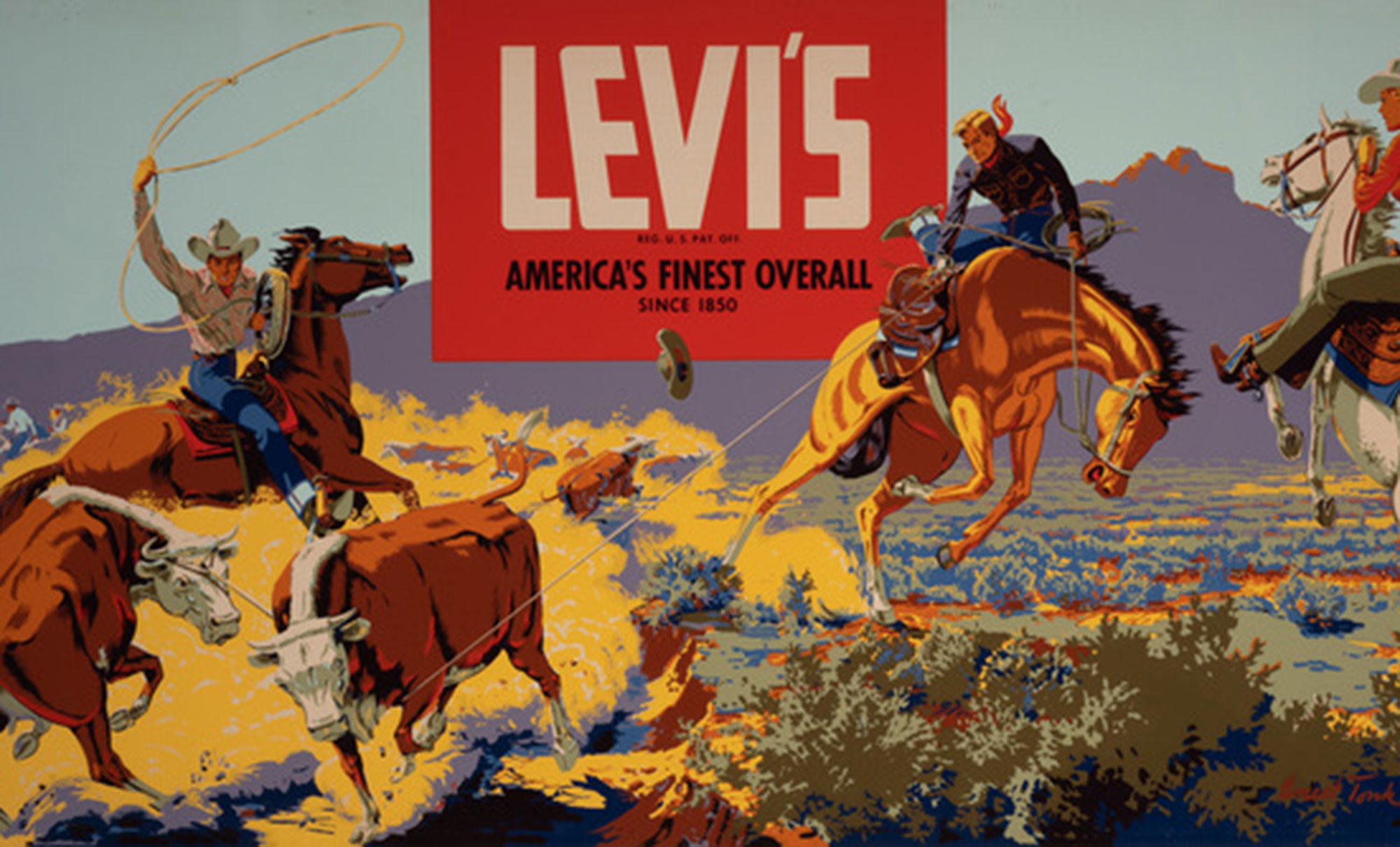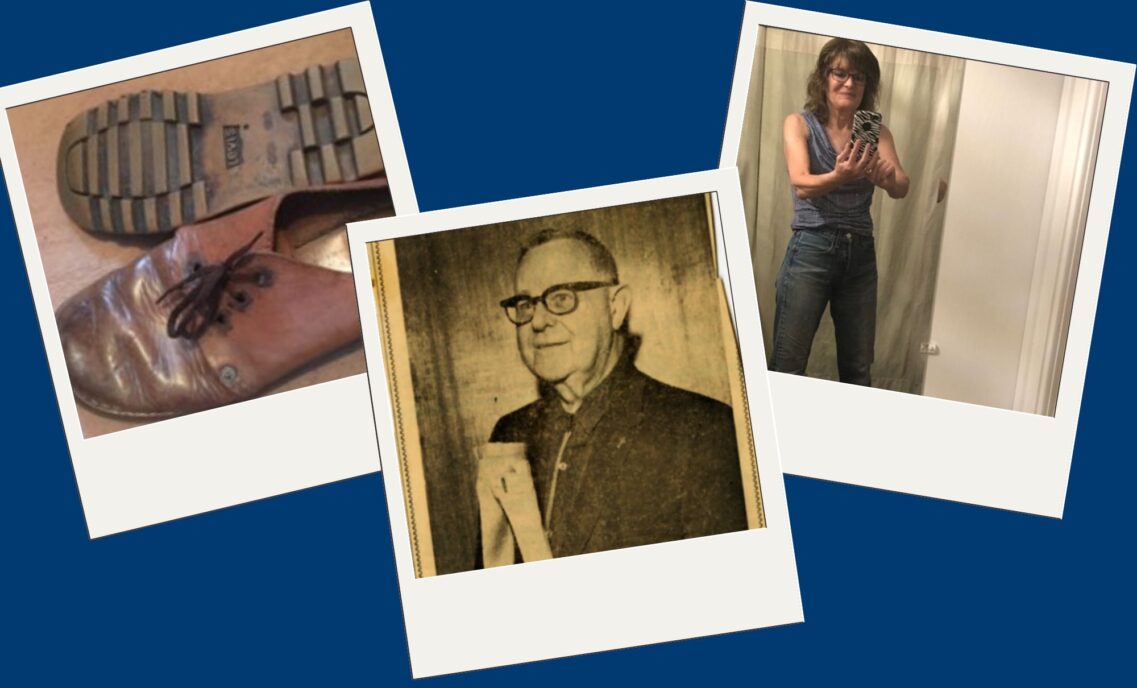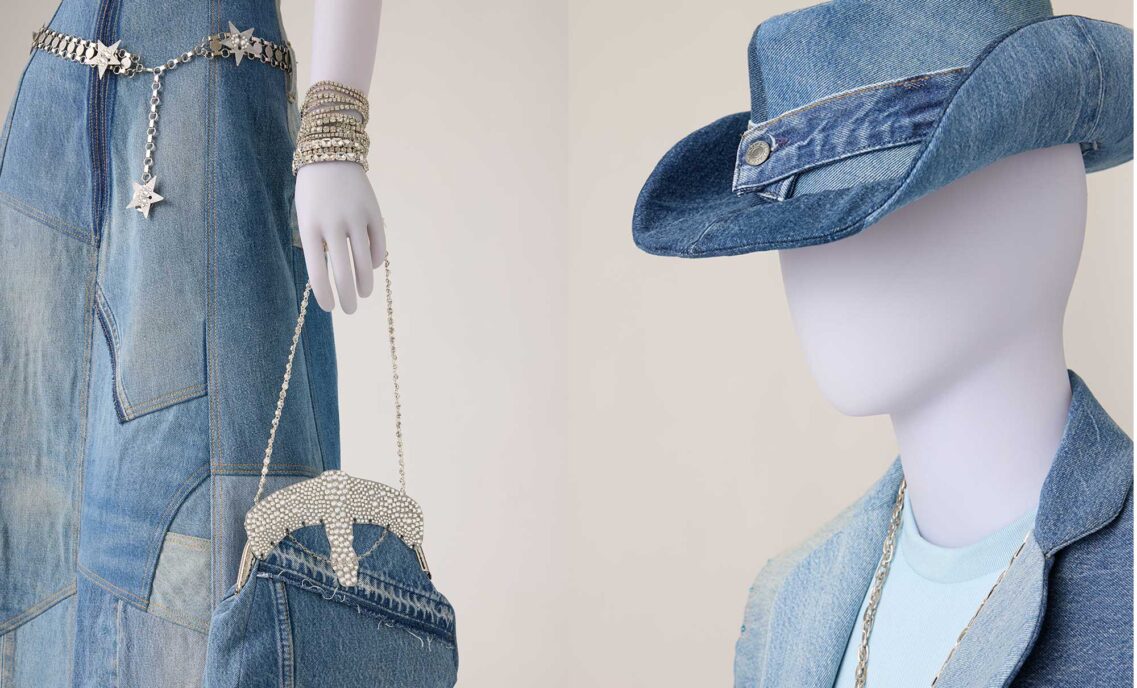Throughout its rich history, Levi Strauss & Co. has done much more than make jeans — it has woven a legacy that stretches far beyond denim, shaping and defining style and culture around the world. Born during the California Gold Rush at a time when the rugged landscape called for durable clothing, Levi Strauss provided garment solutions that would soon become as iconic as the cowboys and ranchers who wore them, transforming the very style of the American West.
Cowboy Connections
LS&Co.’s earliest copper-riveted clothing outfitted workers across America’s Western frontier. The favored garments were our XX denim overalls, spring bottom pants, blouses and jumpers, sack coats and vests. Along with mining, farming and lumberjacking, Levi’s® were tough enough for riding horses and wrangling cattle. And cowboys numbered among the first Levi’s® customers. “All over the west they wear Levi Strauss & Co.’s copper-riveted overalls,” noted a 1901 black-and-white “San Francisco Chronicle” advertisement. The etching featured a cowboy with a lasso riding a horse.
![Left: a 1926 advertisement with a center photo of Lawton Champie in a Levi’s® jumper and cuffed Levi’s® jeans at the Cheyenne Frontier Days Celebration reading “Lawton Champie in Everyday Work Attire — Levi Strauss Overalls and Blouse,” and “[E]very man who received first money was wearing the Two Horse Brand of Overalls...They are truly the Overalls of the Rider of the Range.”Right: a 1901 black-and-white “San Francisco Chronicle” advertisement featuring an etching of a cowboy with a lasso riding a horse and the text, “All over the west they wear Levi Strauss & Co.’s copper-riveted overalls."](https://www.levistrauss.com/wp-content/uploads/2025/08/250808_Western_4-250x151.jpg)
Heading into the late 1920s, cowboys and Western aesthetic began to appear in LS&Co.’s print ads. “Lawton Champie in Everyday Work Attire — Levi Strauss Overalls and Blouse,” read a 1926 advertisement with a center photo of the cowboy in a Levi’s® jumper and cuffed Levi’s ® jeans at the Cheyenne Frontier Days Celebration. “[E]very man who received first money was wearing the Two Horse Brand of Overalls,” continued the flyer. “They are truly the Overalls of the Rider of the Range.”
Outfitting the West
LS&Co. quickly began offering cowboy essentials, such as the Cowboy Overall Shirt, a denim top introduced in 1926 and made of the same fabric as our Levi’s® waist overalls, or 501® jeans. The rugged workwear shirt was LS&Co.’s first western-style shirt, featuring a slanted pocket flap that would later be adopted into our Western Wear line.
Other practical product offerings included a hat, boots and bandana. In one of my favorite photos from the Archives, 1928 Bucking Contest Winner Kenneth Cooper is clad in his Levi’s® cowboy gear in Hollywood, Colorado, standing next to two flappers with their bobbed hair and short dresses.
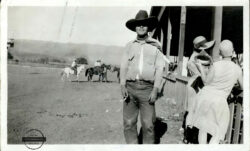
As LS&Co. emerged from the Depression in the 1930s, it began to overtly link itself to the cowboy in advertising and promotions, choosing a cowboy as the symbol to represent the brand and its products. The cowboy had gained popularity and strength in both literature and film as the 20th century progressed — and since cowboys had been early and loyal Levi’s® consumers, it made sense to lean into the image.
At the same time, the idealized concept of the American West was spreading eastwards, informing the “dude ranch craze” of the 1930s and paralleled by a wave of Hollywood Westerns that prominently featured denim — with Levi’s® at the helm. In 1939, John Wayne dressed in cuffed 501® jeans in director John Ford’s Western hit, “Stagecoach.” The Levi’s®-clad cowboy figure would come to symbolize the country.
Lady Levi’s®: The Birth of Women’s Western Wear
In 1934, Levi’s® made history with the groundbreaking introduction of Lady Levi’s® — the first blue jeans made specifically for women. Originally developed for Western women who wore men’s Levi’s® on farms and ranches, this new line acknowledged female pioneers and vacationers alike who desired the same durability and fit enjoyed by men in the West. The jeans catered to women wrangling livestock, riding horses or seeking the adventure of dude ranches — working cattle ranches that took in paying guests — reflecting both the practicality and adventure at the heart of Western culture.
“True Western chic was invented by cowboys, and the moment you veer from their tenets, you are lost,” read a May 15, 1935 Vogue article about dude ranch vacations. “Your uniform for a dude ranch…is simple-but-severe blue jeans or Levi’s, turned up at the bottom once.”
By arriving at the ranch with a “great air of bravado,” concluded Vogue, visitors were sure to have a memorable trip.
A New Western Levi’s® Line
Spurred by Western momentum, many Americans began heading westward with the hopes of experiencing a stay at one of the ever-popular dude ranches. The more resort-like places encouraged visitors to wear jeans, like Vogue advised, but paired with denim jackets, plaid cotton western shirts, gabardine wool shirts, or the rayon satin “rodeo shirts” popular during the era. Seeing an opportunity, LS&Co. launched its first separate Western Wear line around 1937.
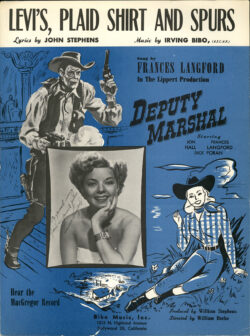 Shirts from the collection featured classic “smile” pockets — or slanted pocket flaps — on the chest. Satin rodeo shirts were offered in bright hues with contrasting color piping. “Colors So Bright They Echo,” read the advertising tagline.
Shirts from the collection featured classic “smile” pockets — or slanted pocket flaps — on the chest. Satin rodeo shirts were offered in bright hues with contrasting color piping. “Colors So Bright They Echo,” read the advertising tagline.
“There’s a fit…a feel… a look…,” exuded a 1940s Levi Strauss Authentic Western Wear advertisement. “For 95 years we’ve been designing and tailoring clothing for the cowboy. That’s why there’s something about Levi Strauss western wear that is different. Why not build your Western Shop around the real thing?”
All-Levi’s® outfits, including copper riveted overalls and riveted denim jackets to Western shirts, were strongly reinforced by Hollywood culture. “Levi’s, Plaid Shirt and Spurs,” crooned Frances Langford in a song of the same name in the 1949 Western film, “Deputy Marshall.”
Illustrating the American West
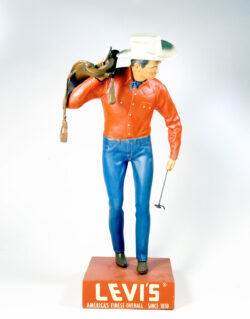 As Western culture continued to grow, LS&Co. leaned into Western advertising. “The Saddleman,” a cowboy figure dressed in Levi’s® jeans, a Western sawtooth shirt, kerchief, cowboy hat and boots began to be used in Levi’s® promotions. Slinging a saddle over one shoulder and holding an “LS” brand in the other like a rancher, Saddleman statues decorated Western wear stores and Saddleman figures appeared on advertisements and on Levi’s® garment labels.
As Western culture continued to grow, LS&Co. leaned into Western advertising. “The Saddleman,” a cowboy figure dressed in Levi’s® jeans, a Western sawtooth shirt, kerchief, cowboy hat and boots began to be used in Levi’s® promotions. Slinging a saddle over one shoulder and holding an “LS” brand in the other like a rancher, Saddleman statues decorated Western wear stores and Saddleman figures appeared on advertisements and on Levi’s® garment labels.
From the 1930s through the 1960s, LS&Co. expanded its cowboy marketing by promoting rodeos, appearing at regional fairs and creating flyers with notices that “genuine Levi’s are worn by all cowboys.” The company gave away cash prizes and silver Levi’s® belt buckles, the bigger the better, to the best cowboys.
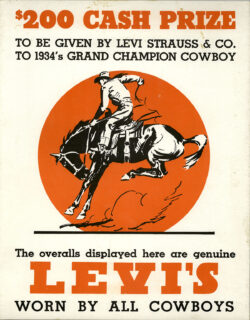
Our advertising footprint also grew, literally and figuratively, as handbills turned into billboards. Vibrant silkscreened Levi’s® murals depicted people dressed in Levi’s® clothing amid breathtaking Western landscapes. The images were mounted on corrugated cardboard and shipped across the West.
After World War II, these Western images were shipped across the country alongside Levi’s® counter cards and advertisements featuring cowboys wearing “America’s Finest Overalls.” The promotions would eventually make their way overseas.
Levi Strauss & Co. saw the potential of the early-twentieth-century cowboy as a transformational figure in the American imagination, identifying and capitalizing on the new market. Alongside the increasingly influential and globally exported Western film genre, Levi’s® Western Wear — and the appealing advertising that accompanied it — helped shape and mirror a new brand of American identity.
Western Evolution: Timeless Appeal and Enduring Legacy
Nearly two centuries since we first introduced our denim riveted clothing, Levi Strauss & Co. has transformed the very style of the American West and the broader globe. Levi’s® garments have become as iconic as the cowboys and ranchers who wore them then, and the modern mavericks who wear them as timeless symbols today.
Today, Western wear icons such as our Levi’s® 501® jeans and Western denim shirts remain staples, while other garments have been reimagined over time. The Levi’s® brand has been adopted as a canvas for Western-imbued self-expression, with stars such as Justin Timberlake and NSYNC bringing bedazzled Western-inspired Levi’s® outfits to the stage.
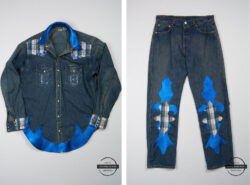
NSYNC Levi’s® for Lance Bass As Worn for “Space Cowboy” (ca 2001)
Most recently, the Levi’s® brand and global icon Beyoncé introduced the Western-inspired BEYONCÉ x LEVI’S® denim collection, featured on stage for the culmination of the “Cowboy Carter” tour.
Levi Strauss & Co. has never strayed from its roots — a legacy built on the American Western frontier woven into every hem, yoke and stitch. Today, Levi’s® Western wear styles endure as a testament to innovation, adventure and timeless style, with our latest Levi’s® looks honoring our historic connection to cowboys and a legacy built on toughness, resilience and adaptability — key traits of those who shaped the West and the clothing they wore.



